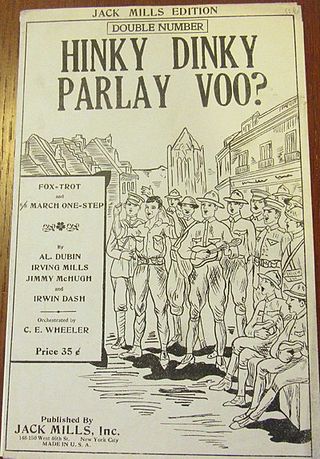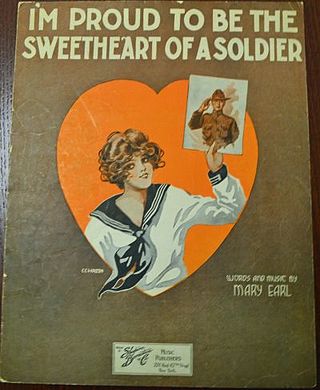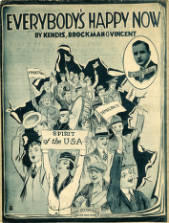
Berlin Bound is a World War I song written in 1918. The lyrics and music were written by James Kendis, James Brockman, and Nat Vincent. Kendis Brockman Music Co. published the song in New York, New York. On the cover of the sheet music is a drawing of soldiers dancing. The piece was written for both voice and piano.

Our Country's in It Now! is a World War I era song released in 1918. Arthur Guy Empey wrote the lyrics. Charles R. McCarron and Carey Morgan composed the music. The song was published by Jos. W. Stern & Co. of New York, New York. On the cover, on both the left and right side, are drawings of soldiers engaged in trench warfare. In the center is a photograph of Arthur Guy Empey dressed in uniform. It is written for voice and piano.

When I Send You a Picture of Berlin: You'll Know It's Over, Over There is a World War I song written and composed by Frank Fay, Ben Ryan and Dave Dreyer. Written for voice and piano, this song was published in 1918 by Harry Von Tilzer Music Publishing Co., in New York, NY. The cover, illustrated by Pfeiffer Illustrating Co., depicts a soldier with a camera while in the background the cavalry rides through a monument. The song was recorded by Arthur Fields & the Peerless Quartet.
"We're Going Over the Top" is a World War I song written by Andrew B. Sterling, Bernie Grossman, and Arthur Lange. It was published in 1917 by Joe Morris Music Co., in New York, NY. The sheet music cover, designed by Starmer, illustrates a battlefield scene with a tank moving over the top of a trench and soldiers inside the trench getting out of the way of the tank. Behind the tank soldiers march up the field.

Keep the Love-Light Burning in the Window Till the Boys Come Marching Home is a World War I song with music and lyrics by Jack Caddigan and Jimmy McHugh. It was first published in May, 1917, a month after the United States entered World War I, by D. W. Cooper Publishing Co., in Boston, MA. By October, Chappell & Co. had brought suit, alleging that the title and refrain violated copyright on the British song, "Keep the Home-Fires Burning". Cooper settled out of court by agreeing to release a second edition, copyrighted October 23, 1917, with revised lyrics and the title "Keep the Love-Light Shining in the Window". In the meantime, Jos. W. Stern & Co. had acquired sole selling rights, and its imprint, along with Cooper's, appeared on the new version. A final edition, issued after Stern & Co. actually acquired the copyright, appeared in 1918.

The Nation's Call for Humanity and Right is a World War I song written by N.A.W. Carty. It was published in 1918 by N.A.W. Carty in Lawrence, MA. The sheet music cover depicts a sailor and a soldier flanking a civilian holding a flag.

"Daddy Mine" is a World War I song released in 1918. Lew Wilson wrote and Alfred Dubin composed this ballad. It was published by M. Witmark & Songs in New York, New York. It was written for both voice and piano.

General Pershing: is a march composed in 1918 by Carl D. Vandersloot and published by Vandersloot Music Publishing Company.

Marching Song of the 318th Eng’rs is a song by Dorothy Rich Godfrey from 1918 and was published by the 318th Engineers.

Some Lonesome Night is a song by George W. Meyer with lyrics by Grant Clarke and George Whiting. It was published in 1918 by Leo Feist Inc.

"Hinky Dinky Parlay Voo?" is a song composed by Al Dubin, Irving Mills, Jimmy McHugh and Irwin Dash in 1924 and published by Jack Mills, Inc. It is a sequel to the popular World War I song, "Mademoiselle from Armentières," having the same refrain.
"Good-bye France " is a World War I song written by Irving Berlin. It was published in 1918 by Waterson, Berlin & Snyder, Inc., in New York City. The sheet music cover, illustrated by Albert Wilfred Barbelle, features French and American soldiers shaking hands with the Statue of Liberty in the background.
"Hock The Kaiser!" is a World War I song written and composed by James H. Hall in 1917. It targets the German emperor Wilhelm II of Germany. The work was self-published by James H. Hall in Chicago, Illinois.

"I'm Proud to Be the Sweetheart of a Soldier" is a World War I song written and composed by Mary Earl. This song was published in 1918 by Shapiro, Bernstein & Co. Inc., in New York City. The sheet music cover, illustrated by E. E. Walton, depicts a young woman in a sailor outfit holding a picture of a soldier.

I'm Glad I Can Make You Cry is a World War I song written and composed by Charles R. McCarron and Carey Morgan. The song was published in 1918 by Jos. W. Stern & Co. in New York, NY. The sheet music cover, illustrated by Starmer, depicts photos of Alice Joyce & Evart Overton, as well as Bessie Hamilton and Gus Hall's Minstrels.
"Give a Little Credit to the Navy" is a World War I song written by Buddy DeSylva & Gus Kahn and composed by Albert Gumble. This song was published in 1918 by Jerome H. Remick & Co., in Detroit, MI.
While You're Over There in No Man's Land, I'm Over Here in Lonesome Land is a World War I song written by Jessie Spiess and composed by Jack Stanley. The song was first published in 1918 by Will Rossiter in Chicago, Il. The sheet music cover, illustrated by Starmer, features a woman knitting with a battle scene above.

Watch, Hope and Wait Little Girl: I'm Coming Back To You is a World War I song written by Lew Brown, and composed by Will Clayton. The song was first published in 1918 by Broadway Music Co. in New York, NY. The sheet music cover was designed by E.E. Walton, and features a young woman in a heart of red, white, and blue, flowers are gathered at her knees
"We Want Our Daddy Dear, Back Home " is a World War I song written by James M. Reilly and composed by Harry De Costa. The song was first published in 1918 by M. Witmark & Sons in New York City. The sheet music cover features a vitagraph photo of Aida Norton and a seated child.
"Three Wonderful Letters from Home" is a World War I song written by Ballard MacDonald & Joe Goodwin and composed by James F. Hanley. The song was first published in 1918 by Shapiro, Bernstein & Co., in New York City. The sheet music cover, illustrated by Albert Wilfred Barbelle, depicts a mother, wife, and daughter writing letters with marching troops and a plane, ship, and tank in the background.













